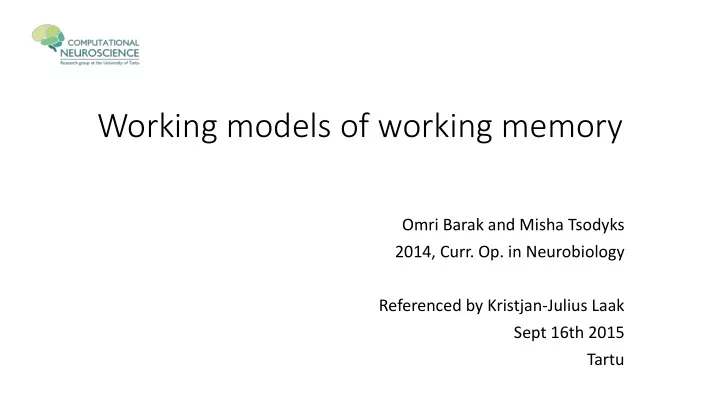

Working models of working memory Omri Barak and Misha Tsodyks 2014, Curr. Op. in Neurobiology Referenced by Kristjan-Julius Laak Sept 16th 2015 Tartu
Working models of working memory
Working models of working memory Def. Holding and manipulating information for short periods of time with no structural changes involved. … refers more to the whole theoretical framework of structures and processes used for the temporary storage and manipulation of information WM
The Magical Number Seven, Plu lus or r Min inus Two: Some Limits on Our Capacity for Processing Information George A. Miller, 1956
For a sequence of words in a sentence you get the structural idea in the end. – example of a WM task
Levels of computation
Challenges Data-driven Analysis of behaviour Manipulate several items simultaneously Neurophysiological observations ∑ Irregular firing patterns ∑ Activity is not stationary ∑ Different neurons have different firing profiles
Challenges Data-driven Computational-driven Analysis of behaviour Network activity should be stable to Manipulate several items retain memories simultaneously Neurophysiological observations ∑ Irregular firing patterns ∑ Activity is not stationary ∑ Different neurons have different firing profiles
Classical idea of WM (still „ working memory) Itskov, Hansel, Tsodyks, Front Comput Neurosci. 2011
Classical idea of WM (still „ working memory) WM – stationary persistent activation of selective neuronal populations
Classical idea of WM (still „ working memory) WM – stationary persistent activation of selective neuronal populations Recent advantages explain WM also by 1. Short-term synaptic plasticity (STSP) 2. Recurrent excitatory and inhibitory networks (I-E) 3. Intrinsic network dynamics
Delay-effect
How can we hold many items simultaneously? or How to overcome the mechanistic challenge of retaining several items in WM?
How can we hold many items simultaneously? or How to overcome the mechanistic challenge of the interference between the activation of different items? Alternatively: Capacity of the network
Overcoming interference: Sparse patterns Every item is represented by a small fraction of neuronal population I-F spiking neuron model Experiment Amit et al. 2003, Cerebral Cortex
Overcoming interference: I-E E balance The balance of inhibition and exhibition determines a) No. of items network can hold b) Mode of failure (fade out, merge) Amit et al. 2003, Cerebral Cortex
Dorsolateral prefrontal cortex (dlPFC)
Edin et al. 2008, PNAS Boosting of capacity through dlPFC top- down signals. dlPFC has nonspecific, excitatory connections to IPS. ( A ) If dlPFC has low activity, only two items are stored. ( B ) When dlPFC activity is high, all four items are remembered.
1. Synaptic facilitation Short-term SF – temporarily modify synaptic efficacy in response to stimuli Rolls et al., 2013 ,PLOS One Phenomenological model of Ca-mediated transmissioon ->
SF continued 1. .. Prolongs memory lifetime by reducing the inherent drift of the system 2. .. Replaces persistent activity!
WM sustained by Ca+ facilitation Mongillo et al., 2008, Science
1200 species of proteins in post syn end, and only 6 Ca+ ions
SF continued 1. .. Prolongs memory lifetime by reducing the inherent drift of the system 2. .. Replaces persistent activity! 3. .. Enables non-linear relationship between pre and post syn neuron
Excitatory recurrent currents (~NMDA) make persistent activity models more realistic Wang et al. 2012 Neuron
2. I-E Balance We know that there is a balance and the activity is irregula r … This has been a puzzle for neuroscientists.
Memories are stabilized by fast inhibition and slow excitation Negative feedback loop idea from engineering
3. Intrinsic dynamic mechanism There’s no persistent activity -> Idea of stable states See also: Maass, et al. 2002, Neural Comput during WM tasks Rainer, Miller, 2002, EJN
Reservoir computing w w Liquid State Machines
But maybe some states? Training initally random network gives better results Barak, et al., 2013, Science Direct
Dynamic attractors – chaotic network + learning Laje, Buonomano, 2013, Nature Neuroscience
Conclusions Biological systems don't choose one mechanism. It is highly possible that many mechanisms mentioned are utilized by the brain.
Thank you! Kristjan-Julius Laak julius.laak@gmail.com Computational Neuroscience lab (neuro.cs.ut.ee) University of Tartu
Recommend
More recommend